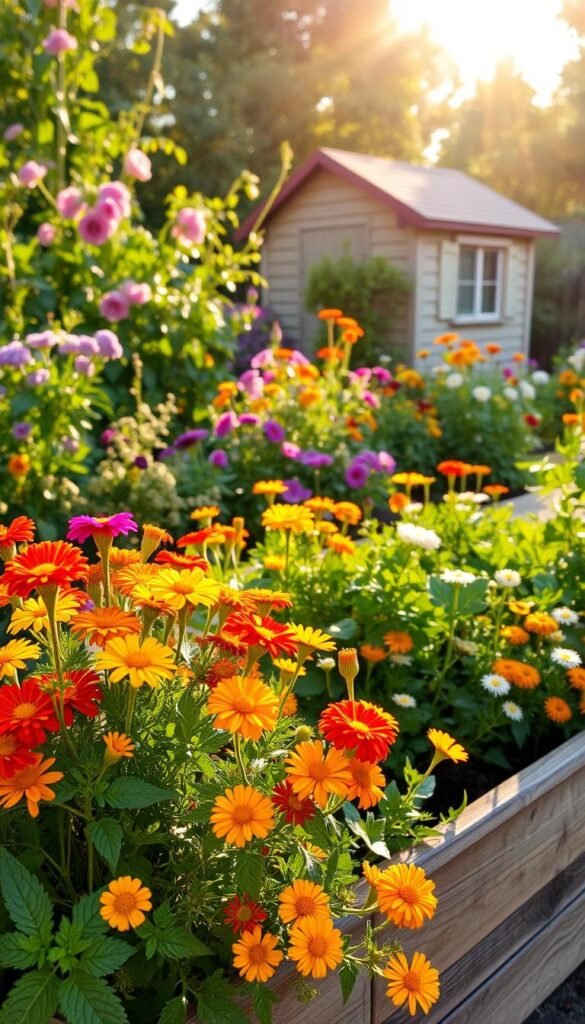Imagine stepping into a space where every petal serves a purpose. Picture vibrant blossoms that dazzle your senses and spice up your meals. This is the magic of growing plants that work double duty—offering visual charm while tantalizing your taste buds.
Why settle for ordinary greenery when you can cultivate something extraordinary? Many home growers are now blending aesthetics with practicality, choosing blooms that add flair to plates as much as to flower beds. From zesty nasturtiums to candy-like pansies, these natural wonders turn salads into art and drinks into conversation starters.
What makes these plants stand out? They’re not just pretty faces. Their flavors range from peppery kicks to honeyed whispers, giving chefs and home cooks endless creative options. Plus, they’re surprisingly easy to grow, thriving in backyard plots or container gardens.
Whether you’re garnishing desserts or brightening up a patio, this approach lets you enjoy nature’s gifts in fresh, flavorful ways. Ready to explore how these colorful additions can redefine your outdoor space—and your kitchen? Let’s dig into the possibilities.
Introduction to Edible Flower Gardens
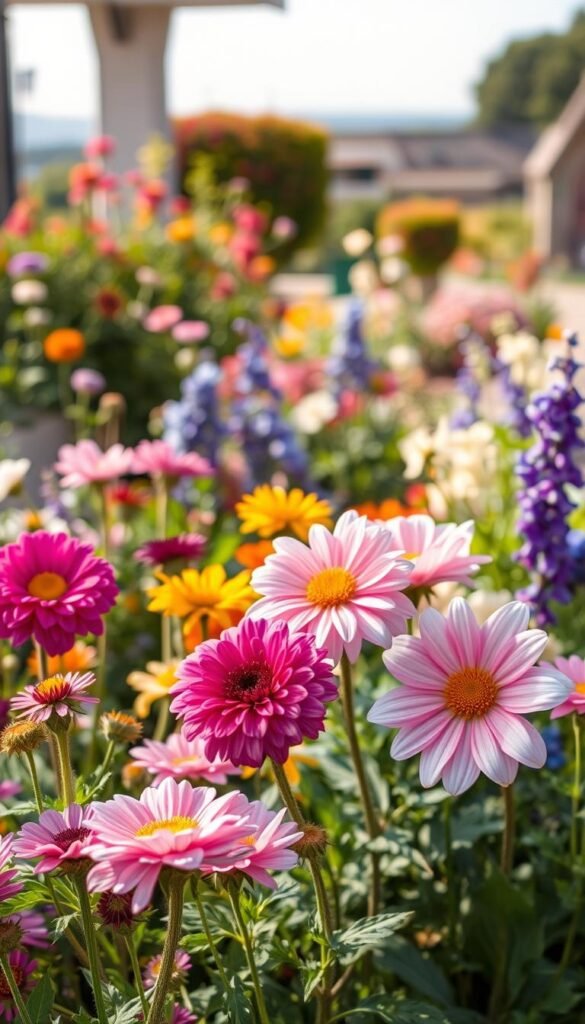
Your backyard could become a canvas where color meets flavor. Picture petals that dazzle your eyes and spark your next recipe. These vibrant plants let you harvest ingredients straight from your outdoor space while creating eye-catching displays.
Why Choose This Dual-Purpose Approach?
These gardens solve two problems at once. They fill your yard with lively hues while stocking your kitchen with fresh, chemical-free ingredients. Perfect for small spaces, they work in raised beds or containers—ideal for urban setups where efficiency matters.
Bridging Aesthetics and Practicality
Growers love how these plants blur lines between decoration and utility. Bright nasturtium leaves jazz up salads, while lavender buds infuse desserts with floral notes. You control what goes into your soil, ensuring safe, organic additions to meals.
| Traditional Garden | Edible Blooms |
|---|---|
| Single-purpose plants | Dual visual/culinary use |
| Requires separate herb beds | Combines flavors and colors |
| Limited seasonal interest | Year-round visual appeal |
Seasoned gardeners and newbies alike find joy here. Each bloom offers new ways to experiment—whether sprinkling petals on soups or freezing them into ice cubes. It’s gardening that feeds both creativity and appetite.
Edible Flower Garden: Top Varieties for Culinary Delights and Gorgeous Blooms
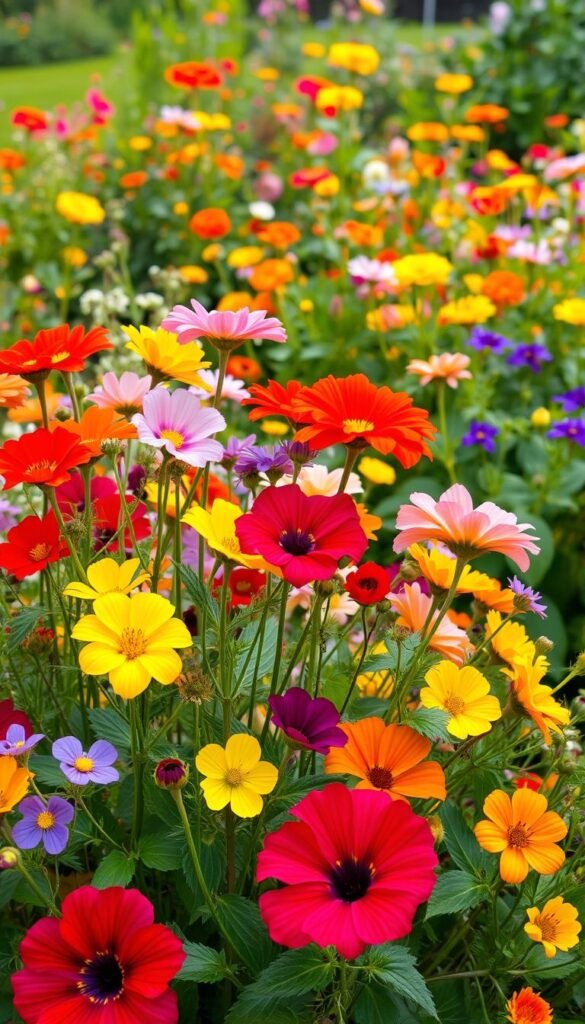
Transform your plate into a painter’s palette with nature’s colorful ingredients. These vibrant picks bring zest to meals while dazzling your outdoor space. Let’s explore six reliable performers that thrive in most U.S. climates.
An Overview of Star Varieties
Nasturtiums kickstart the party with peppery petals perfect for salads. Their fiery orange and yellow hues pop against greenery. Experts recommend pairing them with soft cheeses for balanced bites.
Delicate chive blossoms whisper onion notes into dressings. Purple pompoms add texture to soups. New growers love their resilience—they bounce back after heavy rains.
For citrusy flair, calendula petals brighten rice dishes. Their golden shades make desserts glow. “They’re like edible sunshine,” says a Midwest gardener.
- Borage: Cool cucumber flavor lifts summer drinks
- Lavender: Sweet aroma enhances baked goods
- Violets: Candy-like sweetness decorates cakes
Most thrive in container gardens, needing just 6 hours of sun. Start with 2-3 types matching your favorite recipes. Soon you’ll harvest petals that taste as good as they look!
Popular Edible Flowers and Their Culinary Uses
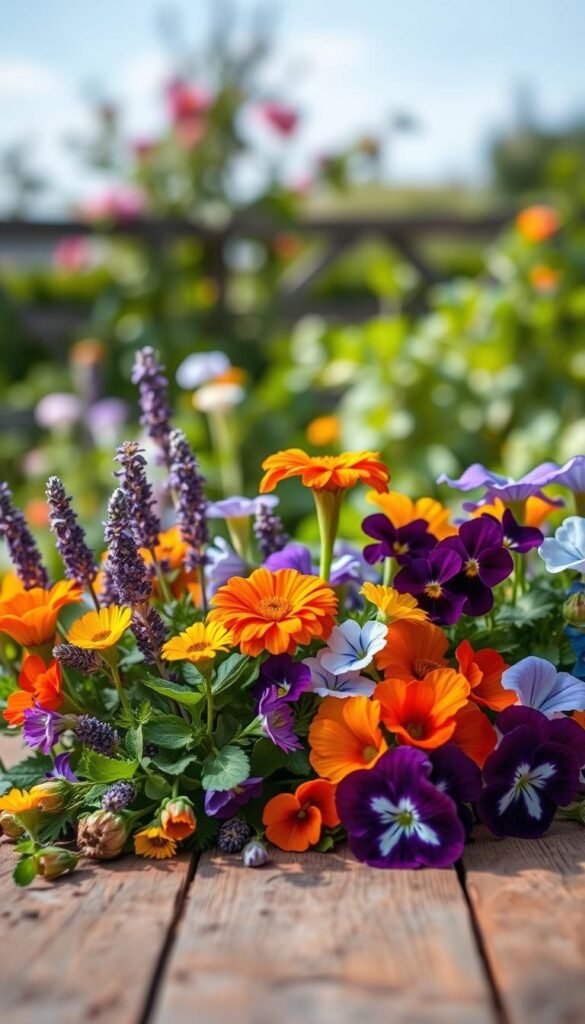
Turn everyday meals into vibrant masterpieces with nature’s flavorful confetti. Three standout varieties – nasturtiums, calendula, and chive blossoms – offer endless ways to upgrade your cooking while keeping your garden lively.
Nasturtiums, Calendula, and Chive Blossoms
Nasturtiums pack a peppery punch like arugula’s feisty cousin. Their circular leaves and sunset-colored petals jazz up salads or act as edible serving bowls for dips. Try these tricks:
- Blend leaves into pesto for zesty pasta
- Press whole blossoms into soft tortillas before heating
- Freeze petals in ice cubes for summer lemonade
Calendula petals work like edible confetti. Sprinkle their golden-orange bits into rice pilaf or whisk into butter for sunny scrambled eggs. Their mild tang balances creamy soups beautifully.
Chive blossoms whisper onion flavor without overpowering. Separate the purple florets to crown deviled eggs or mix into sour cream for potato toppings. They’re especially stunning when tossed over cold noodle salads.
How Flowers Enhance Your Dishes
These blossoms do double duty. Calendula adds saffron-like color to paella at a fraction of the cost. Nasturtium leaves give sandwiches a spicy crunch, while their petals make ordinary green salads Instagram-worthy.
Chive flowers transform simple dips into gourmet spreads. Their delicate onion essence pairs perfectly with goat cheese or ricotta. Pro tip: Use them within hours of picking for maximum flavor and crispness.
Unique Varieties to Explore Beyond the Basics
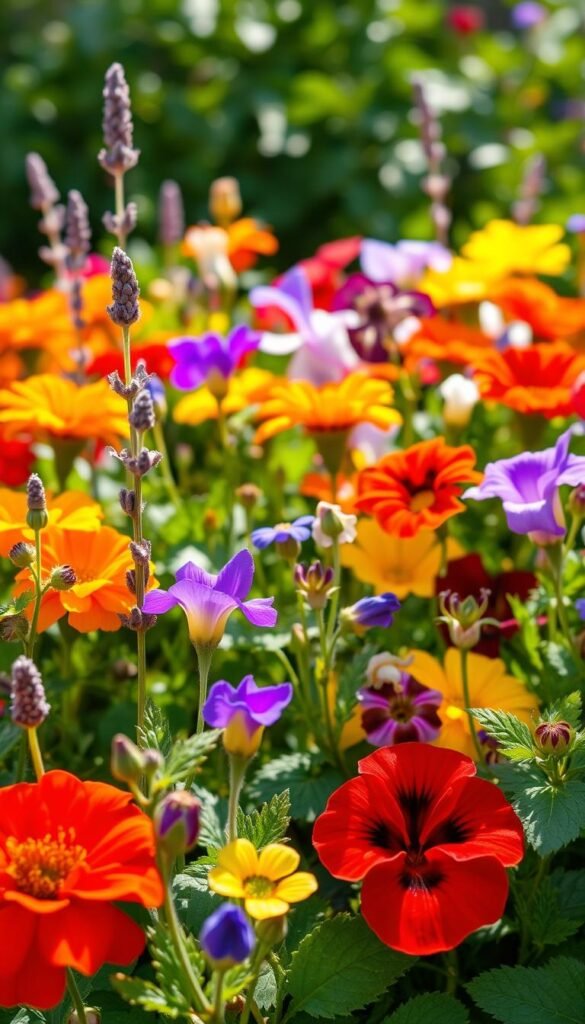
Ready to upgrade your garden from familiar to fascinating? These lesser-known stars bring unexpected flavors and showstopping beauty. Let’s meet four botanical treasures that’ll make your dishes unforgettable.
Elderflowers and Hibiscus
Elderflowers taste like spring captured in a blossom. Their delicate sweetness shines in homemade cordials—perfect for spritzers or drizzling over lemon tarts. Pro tip: Harvest clusters when most buds have opened but aren’t fully bloomed.
Craving tartness? Hibiscus delivers cranberry-like zing. Steep dried petals for ruby-red tea, or make syrup for margaritas. “They turn mocktails into masterpieces,” notes a Texas mixologist.
Distinctive Flavors from Lavender and Borage
Lavender’s fragrant petals elevate desserts without overpowering. A pinch in shortbread dough creates floral magic. For savory twists, sprinkle over roasted carrots or blend into honey butter.
Borage surprises with cucumber-cool blooms. Float star-shaped blue petals in gin tonics or freeze into ice rings for punch bowls. Their mild flavor pairs perfectly with dill-infused salads.
These varieties prove that adventurous gardening pays off. Whether crafting signature cocktails or decorating cakes, you’ll create edible art that sparks conversations. What will you try first?
Culinary Inspiration with Edible Flowers
Turn your kitchen creations into eye-catching spreads that taste as good as they look. Discover how blossoms transform simple meals into vibrant experiences through clever pairing and preparation.
Brightening Up Salads and Garnishes
Nasturtiums bring peppery zing to leafy greens, while pansies offer subtle sweetness. Try these tips:
- Rinse petals gently in cold water—pat dry with paper towels
- Remove bitter white bases from dandelion blossoms
- Pair snapdragon’s earthy notes with goat cheese or avocado
Borage’s star-shaped blooms add refreshing cucumber hints to summer salads. For texture contrast, sprinkle calendula petals over grain bowls. “They make quinoa look like confetti,” says a Seattle food blogger.
Elevate everyday meals beyond decoration. Marinate chive flowers in olive oil for dressings, or layer violets into tea sandwiches. When growing these ingredients, consider patio containers for easy harvesting near your cooking space.
Balance flavors by matching blossom intensity to your dish. Delicate rose petals enhance fruit salads, while bold marigolds stand up to roasted vegetables. Remember: less is often more when introducing floral elements.
Elevating Salads, Desserts, and Beverages
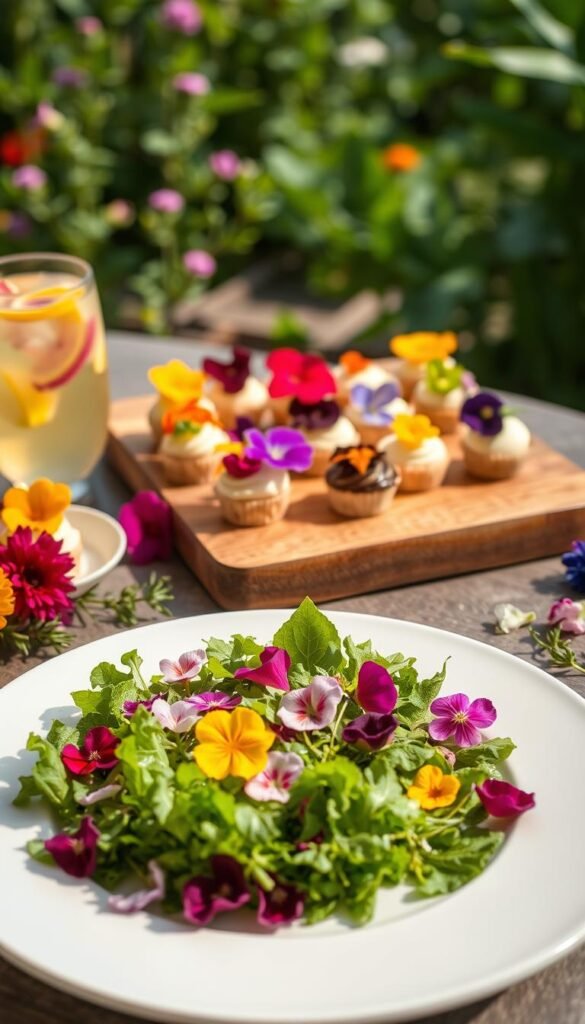
Your next meal could be a canvas waiting for colorful brushstrokes. Whether you’re plating a casual lunch or hosting a dinner party, blossoms add flair to every course. Let’s explore how to weave their magic from appetizers to after-dinner drinks.
Vibrant Touches for Each Course
Start with salads that pop with color. Toss violet petals into mixed greens—their subtle sweetness balances tangy dressings. For mains, sprinkle calendula petals over roasted veggies. Their golden hue mimics saffron’s warmth without the cost.
Desserts become showstoppers with lavender-infused sugar. Dust it over shortbread cookies or stir into lemon sorbet. A pastry chef in Napa Valley notes: “One teaspoon transforms basic batter into something guests rave about.”
| Dish Type | Flower Pairing | Flavor Impact |
|---|---|---|
| Salads | Borage blossoms | Cool cucumber notes |
| Cocktails | Hibiscus petals | Tart cranberry zing |
| Desserts | Candied violets | Delicate sweetness |
Creative Garnishing Ideas
Freeze pansy petals into ice cubes for iced tea—they’ll melt into swirling patterns. Rim cocktail glasses with crushed lavender buds mixed with salt. For dishes needing texture, try tempura-fried squash blossoms stuffed with herbed cheese.
Remember these tips:
- Use hibiscus in margaritas for sunset-red hues
- Infuse olive oil with rosemary flowers for bread dipping
- Layer rose petals between cake tiers with buttercream
Balance is key. Let the taste of petals complement, not overpower. A light hand with floral elements creates meals that delight both eyes and palate.
Herb Blends and Natural Seasonings from Your Garden
Your spice rack just got a backyard upgrade. Those fragrant leaves and petals you’ve nurtured can become custom flavor boosters. With simple techniques, you’ll turn fresh growth into seasonings that outshine store-bought jars.
Crafting Signature Flavors
Sun-dried rosemary and thyme make earthy rubs for meats. Crush them with sea salt for a quick steak seasoning. For Mediterranean vibes, mix oregano blossoms with dried lemon zest.
Try these ideas:
- Blend lavender buds into sugar for floral shortbread
- Infuse olive oil with garlic chive flowers
- Dehydrate mint leaves for tea blends
Freeze herb pastes in ice cube trays—toss one into simmering soups. A Portland chef suggests: “Basil-stems make peppery powder when ground fine.”
Store mixes in airtight jars away from light. Label them with creation dates. Soon you’ll have pantry staples that taste like summer, even in February.

